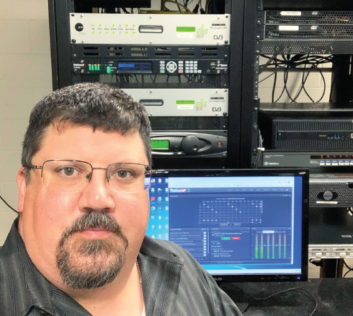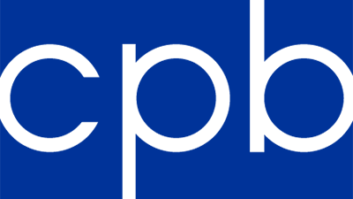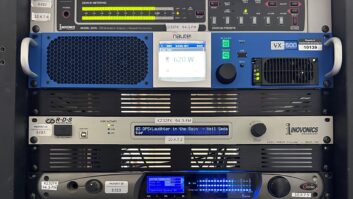TRAVERSE CITY, Mich. — I am the chief engineer for Interlochen Public Radio and the co-owner of Nemosity Enterprises LLC with my wife Tina Marie. At Nemosity Enterprises we focus on broadcast engineering contracting and consulting and I am responsible for 14 FM transmitter sites, studios and facilities across Northern Lower Michigan.
 I began my career as a ground radio repairman in the United States Marine Corps and worked nearly 20 years in television news stations. Four years ago, I made the switch to radio and nothing has felt more like “coming home” than that career move.
I began my career as a ground radio repairman in the United States Marine Corps and worked nearly 20 years in television news stations. Four years ago, I made the switch to radio and nothing has felt more like “coming home” than that career move.
New Installation
My latest project involved Blarney Stone Broadcasting, dramatically expanding the reach of rock and roll station WQON(FM) 100.3 MHz. Q100 is now a combination of WQON, WWMN(FM) 106.3 MHz and WYPV(FM) 94.5 MHz, with live studios in Traverse City and Grayling, Mich. The three FM transmitter sites cover most of the northwestern and central Lower Peninsula (LP) of Michigan.
I’ve worked with Tieline products since 2016 and they are some of the most intuitive, flexible and reliable products I’ve had the pleasure of using. The uptime, ease of operation, flexibility and reliability have been second to none. So when I heard about this new project, I knew Tieline codecs would be ideal as the backbone of this new radio group.
Jerry and Sheryl Coyne own Blarney Stone Broadcasting, and the audience ebbs and flows between 300,000 and 450,000 people, with numbers highest June through September. I presented two options to the director of programming and all-round station guru JJ Rowell. JJ has worked there for years and knows the day-to-day operations better than most. His input and direction was invaluable and he agreed that Tieline codecs would provide flexibility for years to come.
At that time I had three Genie Distribution codecs running two stereo pairs to two sites codecs we use for Interlochen Public Radio, and one Genie and three Bridge-IT XTRAs for Baraga Catholic Radio, which was subsequently sold to Relevant Radio out of Green Bay, Wis. The Blarney Stone Broadcasting project involved installation of a Genie Distribution and three Bridge-IT Pro codecs. The Genie connects using a 3x stereo program configuration.
The Genie at Interlochen has been so reliable in sending two stereo audio streams to the transmitter sites, the budget for putting in a redundant system could be spent on other equipment.
For the new Blarney Stone Broadcasting project, Tieline’s Report-IT mobile app is also important. With smartphone or tablet we can use this codec app to make it possible to broadcast high-quality audio for local sporting events anywhere we have a cellular internet connection with very minimal gear to haul around. The days of packing a carload of equipment to get live local sports on the air are over.
Reliable IP Streaming
Without IP technology joining the Blarney Stone stations would be all but impossible. If you want an IP-based codec system that is reliable and easy to set up and install, Tieline is that system. Installing a reliable, high-quality STL path over IP makes my job easier and less expensive than microwave path studies, licensing, installation and equipment costs. The quality is so good that we use the microwave STL as a Tieline backup at Interlochen Public Radio’s main broadcast site in Traverse City, Mich.
Opus Stereo at 256 kb is my preference for quality and sound; however bandwidth can be a challenge in some areas. Sometimes we dial Opus back to 96 kb if need be or select one of the many other codecs available to tailor each site’s connection. We prefer adaptive jitter buffer settings, which allow packet movement to ebb and flow depending on network load, and use fixed settings if required.
Verizon, AT&T, fiber, local wireless ISPs and Charter Spectrum Cable all play a part in data delivery. Cradlepoint broadband routers with dual SIMs for Verizon and AT&T are also used at some sites. Some have a fiber WAN connection for redundancy and reliability. The biggest challenge in our area is broadband connectivity at some remote transmitter locations. While the terrain makes a tower site attractive because of its height and location, it tends to make fiber installs very expensive, unless one of the main players, Verizon or AT&T are on that site already.
The Tieline codecs are rock-solid, one of the determining factors in choosing Tieline. It takes a major network failure to lose connectivity, and as soon as that network is restored, it comes right back and reconnects automagically.
The Toolbox web-GUI is ideal for configuring multiple peer-to-peer connections and provides the ability to adjust audio matrix routing. This makes adjustments and codec management simple and effective.
I believe the future of broadcasting is in streaming. Streaming content from an IP-based system can be more reliable than satellite distribution. This facilitates having multiple paths, providers and avenues to pull your content. With a satellite system it either works or it doesn’t. And when the Michigan winter rolls in and a foot or two of fresh snow covers your satellite dish, it doesn’t.
Remote control, remote operation and streaming delivery of content are the future. I believe everyone should plan for streaming taking over most content delivery to the station and listeners. I have a feeling Tieline will play a major role in that future, at least for me and my clients.
Radio World User Reports are testimonial articles intended to help readers understand why a colleague chose a particular product to solve a technical situation.
For information, contact Dawn Shewmaker at Tieline in Indiana at 1-317-845-8000. For international contact Charlie Gawley at Tieline in Western Australia at 61-8-9413-2000 or visit www.tieline.com.







